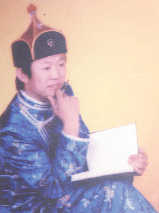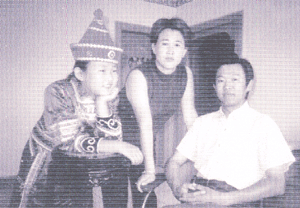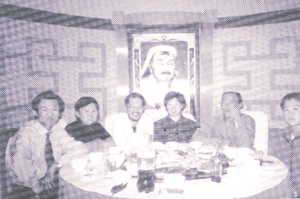| |
|
Southern Mongolian
Human Rights |
|
Information Center (SMHRIC) |
|
June 23, 2005 |
|
New York |
 |
|
|
Mr.Naguunbilig |
|
A popular
Mongolian physician and psychiatrist Mr. Naguunbilig, along with
his wife Daguulaa who worked as assistant to him, was arrested
at his “Inner Mongolian Aztai Mongol Senior’s Health Center” in
Huhhot City in the evening of June 7, 2005, for practicing what
the authorities called a “Mongolian version of Fa Lun Gong”.
Labeled as a “black spot of evil cult and illegal gathering” by
the authorities, his health center was forcibly shut down
following his arrest. Shortly after being held in Inner
Mongolian Public Security Bureau’s Department No. 26, the couple
was transferred to the Hohhot City No.1 Detention Center where
most political dissidents are held before being sent to jail.
Mr.
Naguunbilig, an ethnic Mongolian, was born in western Inner
Mongolia’s Otog Front Banner in 1964. In 1982, he attended the
Inner Mongolian School of Mongolian Medicine and obtained his
Bachelor’s Degree in Mongolian Medicine in 1987. After
graduation, he practiced Mongol-European clinical medicine and
developed his own style of natural healing method based on the
Mongolian medical tradition. In 2000, he created a medical
institute named “Inner Mongolian Otoch Institute of Mongolian
Mental and Physical Health Research”. In 2002, he set up “Inner
Mongolian Aztai Mongol Senior’s Health Center”. From 2001 to
2002, he studied for a Master’s Degree in applied psychology at
Beijing University Medical School. Later he became a Mongolian
medicine specialist, and a member of the Chinese Mental Health
Society and Chinese Medical Chi-kung (or Qi-gong) Institute. He
has published 11 papers in national and international medical
research journals. He is also the author of 5 medical research
books. Prior to his arrest, he was also studying for a Master’s
Degree in Mongolian medicine at Inner Mongolian Medical School.
 |
|
|
Mr.Naguunbilig with his wife and
daughter |
|
An
eye-witness, who asked not to be identified, told the Southern
Mongolian Human Rights Information Center over the phone that
being escorted by three plain clothes policemen, Mr. Naguunbilig
attended his graduation thesis oral examination on the second
day of his arrest. “In order to find evidence to support and
justify their accusation, with the cooperation of the
examination committee, these policemen asked him so many
questions some of which were not even related to the thesis
topic,” said the eye-witness.
“To avoid
unnecessary trouble with the police, Mr. Naguunbilig and other
employees of the Aztai Health Center have always reminded us not
to be in high profile,” said Ms. Huuchinhuu, a cancer patient
who has been detained several times and monitored closely by the
Public Security authorities at eastern Inner Mongolia’s Tongliao
City for supporting and joining the Southern Mongolian
Democratic Alliance (SMDA). SMDA, an underground organization
aimed to bring democracy and self-rule for the region, was
suppressed by the authorities in 1995. “Sometimes he had to
reschedule the lecture for healing at midnight, especially when
as many as 1,000 ethnic Mongolian patients gathered,” Huuchinhuu
said.
 |
|
|
Mr. Naguunbilig with patients from
Ulaanbaatar, Mongolia |
|
Many
underprivileged Mongolians including poor herdsmen from rural
areas and some with salaries from urban cities who had no access
to medical treatments that might cost them their entire annual
household income for a single surgery came to Mr. Naguunbilig
with the hope of healing. Chen Haishan was a member of SMDA. He
was detained for 6 months during the 1995 crack down and also
lost his job due to his political activities. He stayed for
three months at the Aztai Health Center to receive Mr.
Naguunbilig’s treatment. Mr. Naguunbilig treated and cured his
neck problem which, he was told by a Chinese specialist,
otherwise was going to cost him 100,000 yuan for surgical
treatment. In order to relieve her stress, Ms. Shinna, wife of
the prominent political prisoner Hada, visited the Aztai Health
Center several times to attend Mr. Naguunbilig’s lecture for
healing as well. “I had never believed in a miracle until I met
our Great Master Naguunbilig,” said Ms. Otgontsetseg, a
herdswoman from eastern Inner Mongolia’s Ar Horchin Banner who
had suffered a severe paralysis before coming to the Aztai
Health Center. “But I saw a miracle at the Aztai Health Center.
Just after a few days’ treatment and healing, my paralysis has
completely gone! I don’t know how I should thank our Great
Master Naguunbilig for giving me a new life.” Hurelsukh, another
patient who had suffered chronic myelopathy and came in a
wheelchair, has completely recovered under Mr. Naguunbilig’s
treatment, and has decided to voluntarily work for the Center.
 |
|
|
Mr. Naguunbilig with patients from
Japan |
|
According
to these patients, before permanently shutting down the Aztai
Health Center, security personnel frequently harassed its normal
business. Employees and patients were regularly questioned and
monitored by the authorities. Several Mongol yurts which were
built as free dormitories for the patients in the front yard of
the Aztai Health Center were demolished by the City
Beautification Bureau for “disturbing the city scenery”.
About the
authorities’ allegation against Mr. Naguunbilig and the Aztai
Health Center, Mr. Baatar, a former employee of the Center,
revealed to the Southern Mongolian Human Rights Information
Center that the authorities called them “evil cult and illegal
gathering”, “Mongolian version of Fa Lun Gong that makes money
by cheating and lying”. “We have nothing to do with Fa Lun Gong.
What we have practiced is psychological and physical treatment
based on the Mongolian medical tradition and European medical
science that helps cure otherwise incurable diseases. We have
never swindled money from anyone,” said Mr. Baatar over the
phone, “patients pay only 5 yuan (approximately 0.60 USD) for
each 2-hour lecture for healing. It is almost free compared to
any other hospital in Huhhot City.” Mr. Baatar also confirmed
that Naguunbilig and his wife Daguulaa are currently being held
at the Hohhot City No.1 Detention Center where the couple has
been denied the right to communicate with others.
Witnessing
the government’s minority educational policy in Inner Mongolia
that encourages ethnic Mongolian students to learn more Chinese
than their mother tongue from elementary school, Mr. Naguunbilig
has given scholarship to 50 ethnic Mongolian students at poor
rural elementary and middle schools across the region every year
using money from his own pocket. “This is what the government
doesn’t like,” said a student who enjoyed a Naguunbilig
Scholarship when attending Inner Mongolian Mongolian Medical
School and is currently studying in Japan, “because he
encouraged students to learn more Mongolian than Chinese. Except
for the elementary and middle school students, college students
who major in any Mongolian related study are eligible for the
scholarship as well.”
“The true
reason why the government has harshly cracked down on
Naguunbilig and his health center is that the government is too
nervous about any gathering or assembling by the Mongols that
might lead to a possible criticism of its heavy-handed ethnic
policy and ultimately challenge its legitimacy,” said Ms. Shinna
who was on the trip to see her imprisoned husband. Her husband,
Mr. Hada, is now serving his 15 years jail term at Inner
Mongolian No.4 Jail in eastern Inner Mongolia’s Chifeng City for
organizing the SMDA. In another recent incident, many students
were arrested, detained, and questioned by the authorities for
attempting to gather around 1,000 Mongolian students to watch a
popular band from Ulaanbaatar, Mongolia.
Mongolia,
along with China and Tibet, was under the Manchu rule between
1635-1911. Southern Mongolia, widely but mistakenly known as
“Inner Mongolia”, was occupied by Communist China in 1947. Other
than that, no part of Mongolia had ever been part of China.
During the past half a century, Mongols in Southern Mongolia
have not only been deprived of their right to self-governance
but also denied basic human rights and fundamental freedom.
Large numbers of Chinese migrants settled into the region,
making the Mongols an absolute minority on their own land.
Hundreds of thousands of Mongols became subject to persecution
just for being Mongol. |





